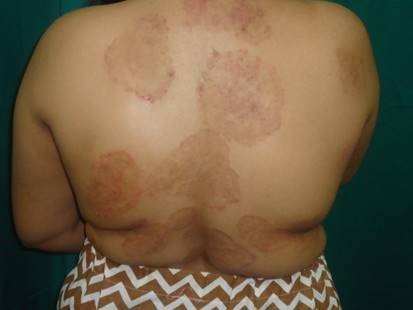Dermatology series- Emerging recalcitrant dermatophytosis in India: Dr. DG Saple
M3 India Newsdesk Jan 15, 2020
Lately, there has been an exponential rise in the atypical and extensive lesions of dermatophytosis, which do not respond as expected- recalcitrant dermatophytosis. Here, Dr. DG Saple focuses on how Dermatophytosis has gone from a localised infection to a new-age epidemic in recent years.

ATTENTION: An image in this article contains a picture of a patient presentation which some people may find offensive or disturbing. Viewer discretion is advised.
Dermatophytosis or Tinea is a fungal infection of the hair, skin or nails caused by a dermatophyte which belongs to either Trichophyton, Epidermophyton or Microsporum genera. The rise and spread of this superficial fungal infection has now attained an epidemic proportion and nearly every city in the country is seeing an overwhelming number of cases of Tinea on a daily basis. This frank spread of infection among the general population, has led us to suspect whether we’ve encountered a resistant species of dermatophytosis. Although, theoretically, we may also be dealing with relapse or recurrent infections, owing to a number of predisposing factors. [1,2]
The most common species responsible for causing the infection are Trichophyton rubrum and Trichophyton mentagrophytes. But, of late, Indian studies conducted across the country are suggestive of Trichophyton mentagrophytes and its sub-species being on the rise. Globally though, T. rubrum continues to be the leading pathogen. [1]
There are a multitude of factors which could be considered responsible for this sudden surge of dermatophytic infections. [2,3]
- Indiscriminate and unsupervised use of OTC steroid preparations are responsible for lowering the local immunity and promoting the growth of the organism.
- Other factors include lifestyle changes- involving the use of occlusive and tight clothing such as jeans. The use of tight-fitting jeans along with the fact that they’re used for prolonged periods without being washed is to blame.
- Obesity, Diabetes Mellitus and the overall rise in temperature owing to global warming, also gives rise to excessive sweating which acts as a contributory factor responsible for this epidemic. [2,3]
The presentation of Tinea has undergone a dramatic change over the past 5 to 6 years and we are now encountering patients presenting with extensive lesions occurring at atypical sites such as the face, forehead etc., recurrent/relapsing lesions, intractable and persistent itching even after the cutaneous lesions have resolved, involvement of most of the family members and even the involvement of infants and children which was quite uncommon in the past.
The previously classical and well-defined lesions of Tinea are observed less frequently and what we are now observing are florid large patches appearing at unusual sites over the body (Fig 1.). Such a picture was previously seen only in immunocompromised patients. However, in today’s times, even healthy individuals are presenting with this clinical picture, called Tinea incognito. [3]

Fig. 1: Extensive and multiple lesions of Tinea (click on the image to view)
Recalcitrant Dermatophytosis and its management has now become a hot topic of discussion at all conferences, national and international. This has led us to explore new avenues and delve further into the reasons for such an epidemic and carry out deeper research.
Host factors
According to a publication in the Journal of American Academy of Dermatology, the host immunity is now being implicated in the causation and is said to play a vital role for bringing about chronic dermatophytosis. A defect in selective, cell-mediated cellular immunity has been attributed for causing prolonged chronic T. rubrum infection. Also humoral immunity with antibodies against the dermatophyte antigen are not adequate in clearing the infection. [4,5]
Agent factors
A lot of culture studies and PCR studies have revealed that there are no new species, but they’re the subspecies of the original T. mentagrophyte complex and T. rubrum complex. [4]
Drug Factors
Various institutions are conducting drug resistance studies and trials to decipher whether there is actually any evidence for the development of drug resistance and found that in most of the cases, increasing dose, over the minimum inhibitory concentration (MIC), was enough to produce clinical and mycological cure. Thus, this emphasises the fact that most of the cases are of clinical failure, rather than resistance.
Till date, the only drug shown for development of resistance is Terbinafine, although the reports of such resistance are sporadic. But, clinicians still continue to get satisfactory results by doubling the dose of Terbinafine. The other systemic drugs like Itraconazole is still effective at the previous MIC values. Griseofulvin is the drug of choice for Tinea capitis. [5,6]
To conclude, dermatophytosis is now established as a chronic disease and is becoming an epidemic, and a dedicated research is required to determine the cause of such an infection, since, till date, there is barely any published data regarding the same.
In the upcoming articles of the series, Dr. Saple will discuss about diagnosis, drug resistance, treatment and the role of steroids for Dermatophytosis. Stay tuned.
Click here to see references
Disclaimer- The views and opinions expressed in this article are those of the author's and do not necessarily reflect the official policy or position of M3 India.
The author, Dr. DG Saple is a Senior Consultant and Director of Dermatology at a Mumbai-based clinic.
-
Exclusive Write-ups & Webinars by KOLs
-
Daily Quiz by specialty
-
Paid Market Research Surveys
-
Case discussions, News & Journals' summaries